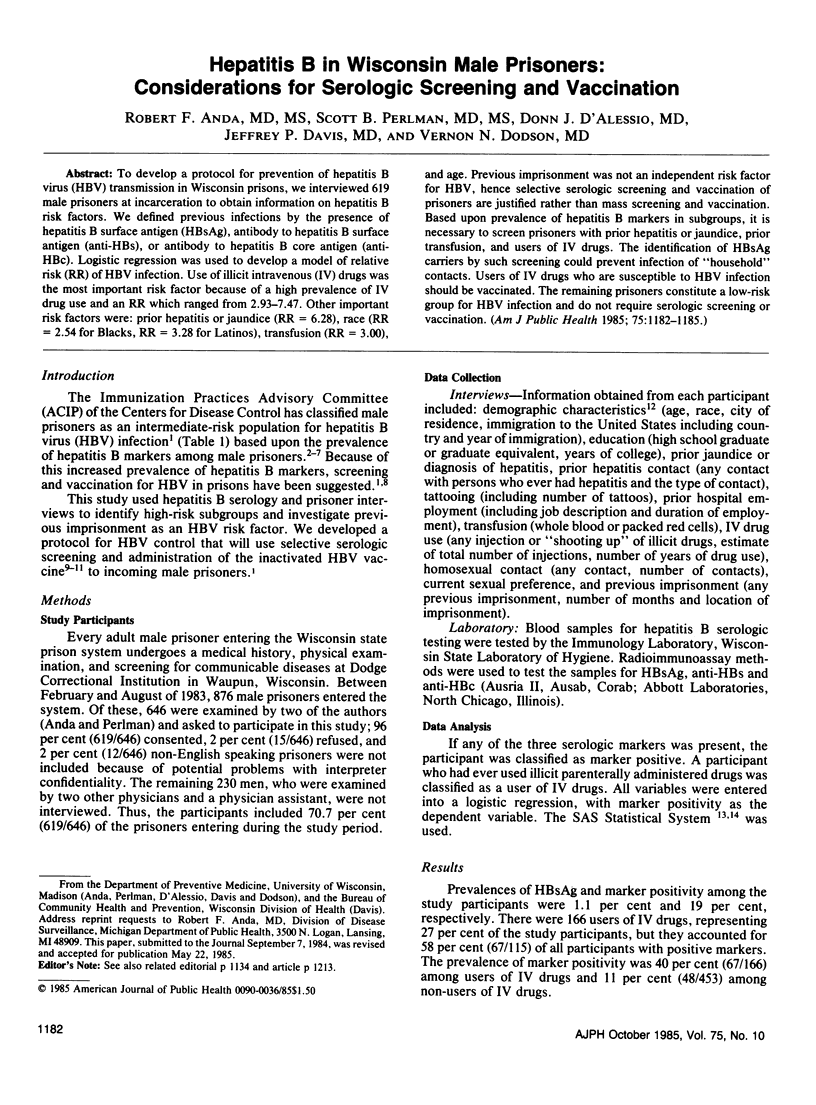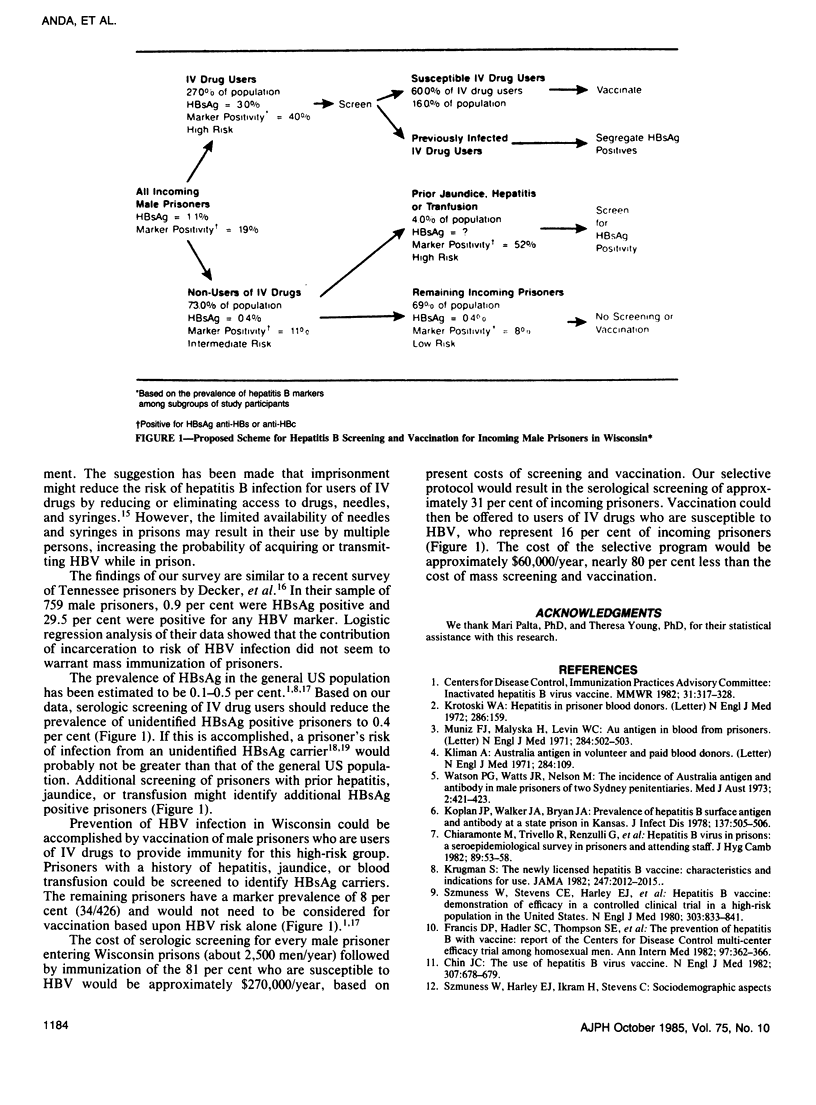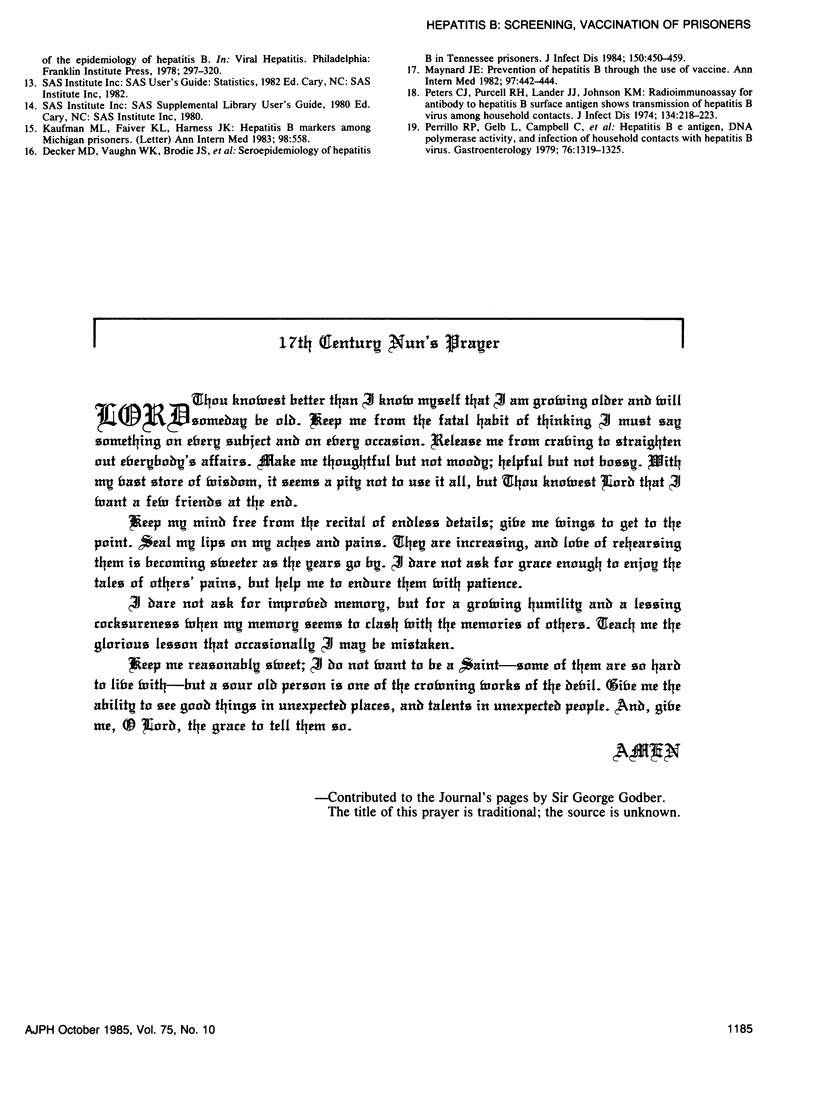Abstract
To develop a protocol for prevention of hepatitis B virus (HBV) transmission in Wisconsin prisons, we interviewed 619 male prisoners at incarceration to obtain information on hepatitis B risk factors. We defined previous infections by the presence of hepatitis B surface antigen (HBsAg), antibody to hepatitis B surface antigen (anti-HBs), or antibody to hepatitis B core antigen (anti-HBc). Logistic regression was used to develop a model of relative risk (RR) of HBV infection. Use of illicit intravenous (IV) drugs was the most important risk factor because of a high prevalence of IV drug use and an RR which ranged from 2.93-7.47. Other important risk factors were: prior hepatitis or jaundice (RR = 6.28), race (RR = 2.54 for Blacks, RR = 3.28 for Latinos), transfusion (RR = 3.00), and age. Previous imprisonment was not an independent risk factor for HBV, hence selective serologic screening and vaccination of prisoners are justified rather than mass screening and vaccination. Based upon prevalence of hepatitis B markers in subgroups, it is necessary to screen prisoners with prior hepatitis or jaundice, prior transfusion, and users of IV drugs. The identification of HBsAg carriers by such screening could prevent infection of "household" contacts. Users of IV drugs who are susceptible to HBV infection should be vaccinated. The remaining prisoners constitute a low-risk group for HBV infection and do not require serologic screening or vaccination.
Full text
PDF



Selected References
These references are in PubMed. This may not be the complete list of references from this article.
- Chiaramonte M., Trivello R., Renzulli G., Zampieri L., Fanecco A., Floreani A., Naccarato R. Hepatitis B virus infection in prisons. A seroepidemiological survey in prisoners and attending staff. J Hyg (Lond) 1982 Aug;89(1):53–58. doi: 10.1017/s0022172400070534. [DOI] [PMC free article] [PubMed] [Google Scholar]
- Chin J. The use of hepatitis B virus vaccine. N Engl J Med. 1982 Sep 9;307(11):678–679. doi: 10.1056/NEJM198209093071110. [DOI] [PubMed] [Google Scholar]
- Decker M. D., Vaughn W. K., Brodie J. S., Hutcheson R. H., Jr, Schaffner W. Seroepidemiology of hepatitis B in Tennessee prisoners. J Infect Dis. 1984 Sep;150(3):450–459. doi: 10.1093/infdis/150.3.450. [DOI] [PubMed] [Google Scholar]
- Francis D. P., Hadler S. C., Thompson S. E., Maynard J. E., Ostrow D. G., Altman N., Braff E. H., O'Malley P., Hawkins D., Judson F. N. The prevention of hepatitis B with vaccine. Report of the centers for disease control multi-center efficacy trial among homosexual men. Ann Intern Med. 1982 Sep;97(3):362–366. doi: 10.7326/0003-4819-97-3-362. [DOI] [PubMed] [Google Scholar]
- Kaufman M. L., Faiver K. L., Harness J. K. Hepatitis B markers among Michigan prisoners. Ann Intern Med. 1983 Apr;98(4):558–558. doi: 10.7326/0003-4819-98-4-558_1. [DOI] [PubMed] [Google Scholar]
- Kliman A. Australia antigen in volunteer and paid blood donors. N Engl J Med. 1971 Jan 14;284(2):109–109. doi: 10.1056/NEJM197101142840220. [DOI] [PubMed] [Google Scholar]
- Koplan J. P., Walker J. A., Bryan J. A., Berquist K. R. Prevalence of hepatitis B surface antigen and antibody at a state prison in Kansas. J Infect Dis. 1978 Apr;137(4):505–506. doi: 10.1093/infdis/137.4.505. [DOI] [PubMed] [Google Scholar]
- Krotoski W. A. Hepatitis in prisoner blood donors. N Engl J Med. 1972 Jan 20;286(3):159–159. doi: 10.1056/NEJM197201202860316. [DOI] [PubMed] [Google Scholar]
- Krugman S. The newly licensed hepatitis B vaccine. Characteristics and indications for use. JAMA. 1982 Apr 9;247(14):2012–2015. [PubMed] [Google Scholar]
- Maynard J. E. Prevention of hepatitis B through the use of vaccine. Ann Intern Med. 1982 Sep;97(3):442–444. doi: 10.7326/0003-4819-97-3-442. [DOI] [PubMed] [Google Scholar]
- Muniz F. J., Malyska H., Levin W. C. An antigen in blood from prisoners. N Engl J Med. 1971 Mar 4;284(9):501–502. [PubMed] [Google Scholar]
- Perrillo R. P., Gelb L., Campbell C., Wellinghoff W., Ellis F. R., Overby L., Aach R. D. Hepatitis B e antigen, DNA polymerase activity, and infection of household contacts with hepatitis B virus. Gastroenterology. 1979 Jun;76(6):1319–1325. [PubMed] [Google Scholar]
- Peters C. J., Purcell R. H., Lander J. J., Johnson K. M. Radioimmunoassay for antibody to hepatitis B surface antigen shows transmission of hepatitis B virus among household contacts. J Infect Dis. 1976 Sep;134(3):218–223. doi: 10.1093/infdis/134.3.218. [DOI] [PubMed] [Google Scholar]
- Szmuness W., Stevens C. E., Harley E. J., Zang E. A., Oleszko W. R., William D. C., Sadovsky R., Morrison J. M., Kellner A. Hepatitis B vaccine: demonstration of efficacy in a controlled clinical trial in a high-risk population in the United States. N Engl J Med. 1980 Oct 9;303(15):833–841. doi: 10.1056/NEJM198010093031501. [DOI] [PubMed] [Google Scholar]
- Watson P. G., Watts J. R., Nelson M. The incidence of Australia antigen and antibody in male prisoners of two Sydney penitentiaries. Med J Aust. 1973 Sep 1;2(9):421–423. doi: 10.5694/j.1326-5377.1973.tb115203.x. [DOI] [PubMed] [Google Scholar]


